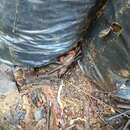Comprehensive Description
provided by Smithsonian Contributions to Zoology
Armases occidentale (Smith, 1870)
Sesarma occidentalis Smith, 1870:158.
Sesarma (Holometopus) occidentalis.—Rathbun, 1897a:90.—Nobili, 1901:42.—Tesch, 1917:179.—Bott, 1955:63.
Sesarma (Holometopus) festae Nobili, 1901:42.
Sesarma (Holometopus) biolleyi Rathbun, 1906:100; 1918:299, fig. 148.—Abele, 1977a:632, figs. 1, 2, 3a-3h.
Sesarma (Holometopus) festae.—Rathbun, 1910:590; 1918:313.
MATERIAL EXAMINED.—Ecuador: Esmeraldas, 3 (coll. no. 5) (paratypes of S. festae), E. Festa, MIZS Cr 198.
Colombia: Tumaco, 3, 4 (coll. no. 3) (syntype of S. festae), E. Festa, MIZS Cr 91.
Panama: Pacific coast, Naos Island, 4, 3 (coll. no. 2), L.G. Abele, 10 Jun 1969; Albrook Air Force Base, swamp, 1 (10 Jun 1969); 3, 6 (coll. no. 4, 23 Aug 1972), 3 (6 Dec 1968), 2 (6 May 1969), L.G. Abele; Pearl Islands, Mina Island mangrove swamp, 5 (coll. no. 1), L.G. Abele; Pearl Island, Contadora Island mangrove swamp, 2, 3, L.G. Abele; Rio Mar above beach, 1, L.G. Abele.
Costa Rica: Boca del Jesus Maria, 1 (holotype of S. biolleyi), Jan 1906, P. Biolley and J.F. Tristan, USNM 32490.
El Salvador: Acajutla, 2 (syntypes of S. occidentale), F.H. Bradley, YPMNH 545.
DESCRIPTION.—Carapace not inflated, slightly wider than long (cl/cb is 0.95±0.02 in males and 0.93±0.02 in females). Carapace increases in width posteriorly, a very slight emargination posterior to outer orbital angle; dorsal surface covered with low but distinct granules. Interorbital region subdivided into four low lobes. Frontal region widens slightly distally (more apparent in larger specimens); about 0.55 of cb.
Basal segment of antennula large, granulated, and located beneath the frontal margin. Basal antennal segment forming portion of lower orbit fitting up against a triangular lobe. A groove (Verwey's groove; von Hagen, 1978) extends from exhalent opening along pterygostomial region parallel to lower orbital margin; a weaker groove runs at an oblique angle from each end of Verwey's groove, delimiting a triangular area below orbit.
Chelipeds sexually dimorphic. In both sexes merus has medial posterior edge serrated; anterior edge expanded with well-developed teeth (especially in mature males) continuing to distal margin. Carpus covered with acute granules, especially along borders. Chelae of both sexes covered with acute tubercles; in males chelae swollen with large process or protuberance on medial surface of palm at base of dactylus. Dactylus broader at base in males than in females.
Walking legs long, relatively slender; ratio of merus length to width varies among legs and with size and sex of animal; ratio of fourth leg (fifth pereiopod) of small males about 2.5, for large males about 3.0. For a series of males ratio of third (longest) leg ranged from 2.6 to 3.0; in females it ranged from 2.6 to 2.9. Ratio increases with increasing size in both sexes. For longest leg merus length slightly less than twice carpus length; about 1.3 times propodus length and slightly less than twice dactylus length. Mature males with row of thick pubescence along ventral portion of propodus and dactylus; also pubescence along dorsal portion of propodus, but the hairs more robust.
Propodi and dactyli armed with small, black spines, on ventral margin of propodus and on both ventral and dorsal margins of dactylus. About five spines in widely separated pairs along ventral portion of propodus with two more pairs on distal margin. Spines of dactylus in two poorly defined rows on dorsal and ventral surface; number and strength of spines increase with increasing size. Spines present in females but reduced in number.
Male gonopod simple and unarmed; endpiece (amber-colored apex) relatively small and set at an oblique angle to main axis of gonopod. Gonopod with distinct expanded portion proximal to endpiece.
Female gonopore raised from sternum and flanked anteriorly and posteriorly by extensions of sternum; between these is a barbell-shaped process.
MEASUREMENTS.—Males, cb 7.3 to 22.0 mm; females, cb 7.3 to 15.0 mm; ovigerous females, cb 10.1 to 14.8 mm. Males larger than about cb 11.0 mm appear to be mature, whereas females appear to attain sexual maturity at about 10.0 mm.
TYPE LOCALITY.—Acajutla, El Salvador.
TYPE.—Two male syntypes are deposited in the YPMNH.
DISTRIBUTION.—The species is widely distributed in the eastern Pacific from Esmeraldas, Ecuador, to at least Acajutla, El Salvador.
HABITAT.—Armases occidentale is semiterrestrial and occurs in a wide variety of habitats up to 80 m from water. Individuals were collected from under litter along the edge of a brackish water stream, from a dried river bed along the edge of a red mangrove swamp and from among piles of lumber in back of the bunker of the Smithsonian Tropical Research Institute at Naos Island, Panama.
- bibliographic citation
- Abele, Lawrence G. 1992. "A review of the Grapsid crab genus Sesarma (Crustacea: Decapoda: Grapsidae) in America, with the description of a new genus." Smithsonian Contributions to Zoology. 1-60. https://doi.org/10.5479/si.00810282.527

